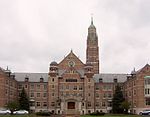Worthington Kilbourne High School
1991 establishments in OhioEducational institutions established in 1991High schools in Columbus, OhioHigh schools in Franklin County, OhioPublic high schools in Ohio ... and 1 more
Worthington, Ohio

Worthington Kilbourne High School (WKHS) is a public school located in Columbus, Ohio and is part of the Worthington City School District. Kilbourne was named after James Kilbourne, the founder of the city of Worthington. The school colors are black and royal blue and a gray wolf named "Lobo" is the mascot. The current principal is Aric Thomas. Within the Worthington City School District, students who attend McCord Middle School, Perry Middle School, and students from Phoenix Middle School who would traditionally attend McCord or Perry feed into WKHS.
Excerpt from the Wikipedia article Worthington Kilbourne High School (License: CC BY-SA 3.0, Authors, Images).Worthington Kilbourne High School
Hard Road, Columbus
Geographical coordinates (GPS) Address External links Nearby Places Show on map
Geographical coordinates (GPS)
| Latitude | Longitude |
|---|---|
| N 40.116111111111 ° | E -83.055555555556 ° |
Address
Worthington Kilbourne High School
Hard Road
43235 Columbus
Ohio, United States
Open on Google Maps








